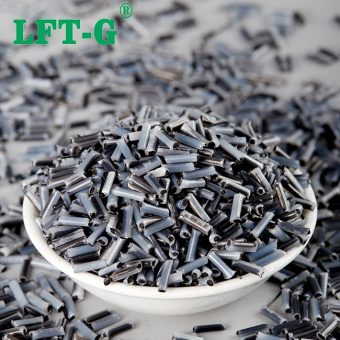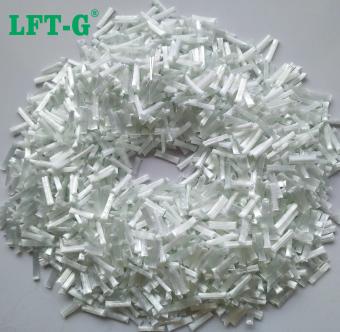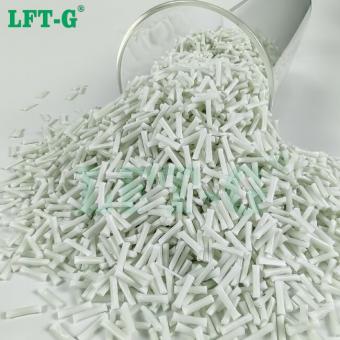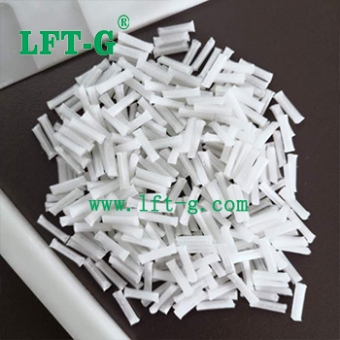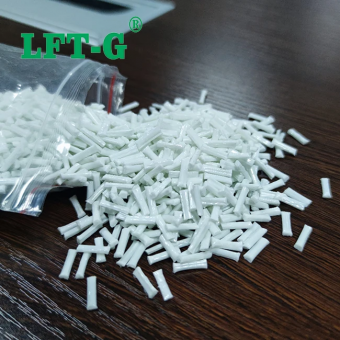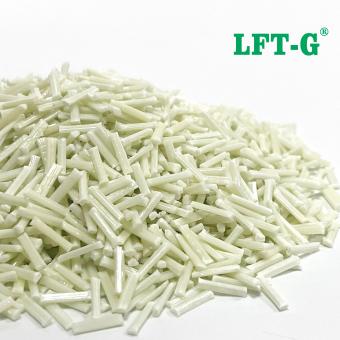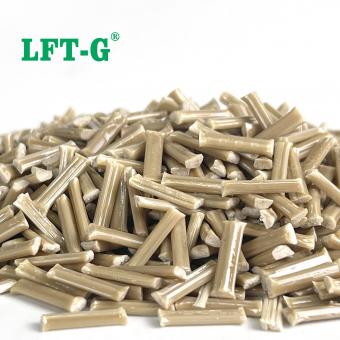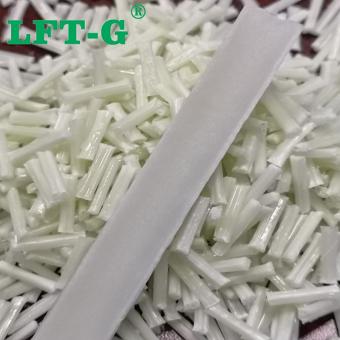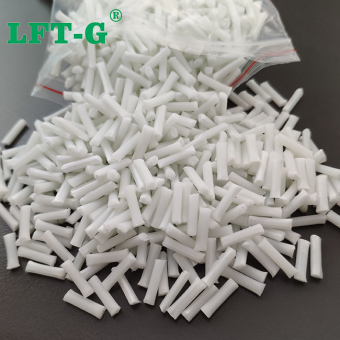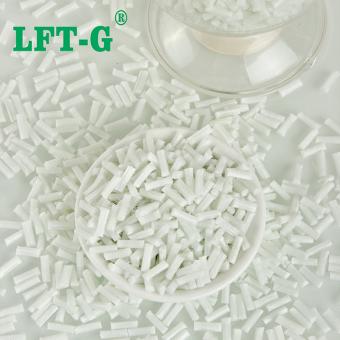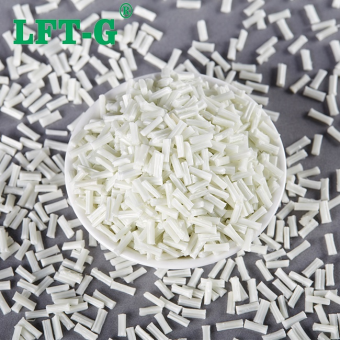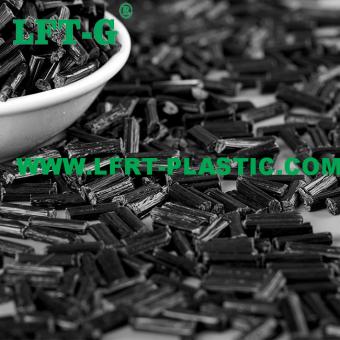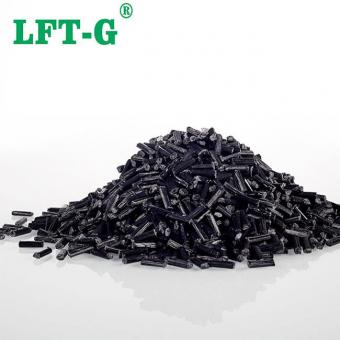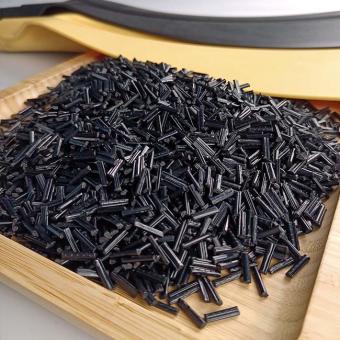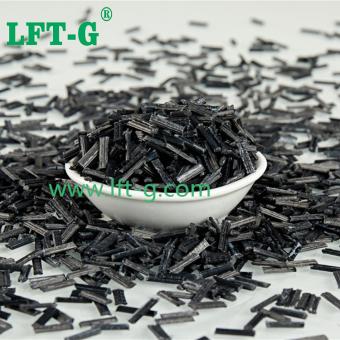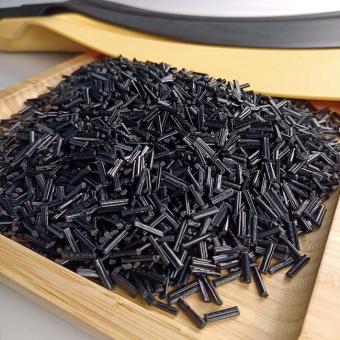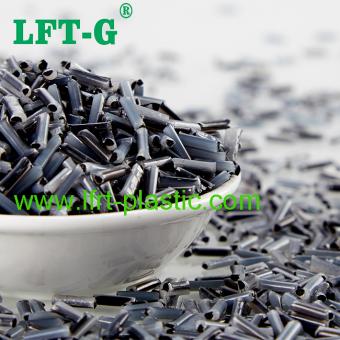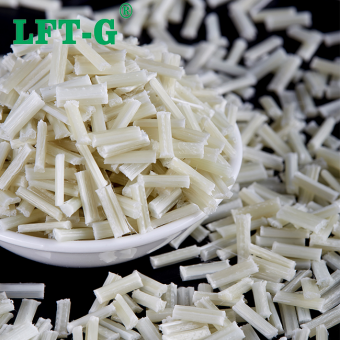-
China famous brand MXD6 conposite long glass fiber lgf for injection molding thermoplastic resinMXD6 introduction Polyhexanediyl m-dimethylamine, referred to in English as mxd6, generally referred to as "nylon mxd6", the resin has higher mechanical strength and modulus than other engineering plastics, but also a special high barrier nylon material. Nylon mxd6 is one of aromatic and aliphatic polyacyl limbs, which is produced by m-phenylenedimethylamine and adipic acid. In industrial production, in order to make the raw materials economical and easy to obtain, often mixed xylene as raw materials, first made of m-phenylene dimethylamine content higher than 70% of mixed benzene dimethylamine, and then with adipic acid to generate salt, in the presence of a small amount of stabilizer adipic acid and appropriate amount of water for the pressure condensation reaction, the resulting polymer is a hybrid. Although the barrier property of mxd6 is a little less than that of pvdc and evoh, its barrier property is not affected by temperature and humidity, which is especially suitable for high temperature and humid occasions. In today's barrier packaging and the general trend to replace steel with plastic, nylon mxd6 has become one of the striking new plastic varieties. Advantages 1、Maintain high strength and rigidity in a wide temperature range 2、High heat deflection temperature, small coefficient of thermal expansion 3、Low water absorption, small size change after water absorption, less mechanical strength reduction 4、Small shrinkage rate of molding, suitable for precision molding process 5、Excellent paintability, especially suitable for surface painting under high temperature 6、Excellent barrier to oxygen, carbon dioxide and other gases Long glass fiber compounds Long glass fiber reinforced composites can solve your problems when other methods of reinforced plastics do not provide the performance you need or if you want to replace metal with plastic. Long glass fiber reinforced composites can cost-effectively reduce the cost of goods and effectively improve the mechanical properties of engineering polymers, and increase the durability by forming long fibers to form a long-fiber-reinforced internal skeleton network. Application MXD6 can be filled with glass fibers to create a glass fiber reinforced material containing 20-60% glass fiber with exceptional strength and stiffness. Even when filled with high levels of glass fiber, its smooth, resin-rich surface creates a high gloss surface as without glass fiber, making it ideal for painting, metal coating or creating naturally reflective housings. 1、High fluidity for thin wall It is a very high flowing resin that can easily fill thin walls as thin as 0.5 mm in thickness even when the glass fiber content is as high as 60%. 2、Excellent surface finish The resin-rich perfect surface has a highly polished appearance, even with a high glass fiber content. 3、Very high strength and stiffness With 50-60% glass fiber reinforcement, MXD6 has tensile and flexural strengths similar to many cast metals and alloys. 4、Good dimensional stability At ambient temperature, the coefficient of linear expansion (CLTE) of MXD6 glass fiber composite is similar to that of many cast metals and alloys. It is highly reproducible due to low shrinkage and the ability to maintain tight tolerances (length tolerances can be as low as ± 0.05% if properly formed). MXD6 replaces metal in the production of high-quality structural parts for automobiles, electronics, and appliances In automotive parts, many occasions require material products with high mechanical strength and good oil resistance, and can be used in the range of 120 ~ 160 ℃ for a long time. Glass fiber reinforced MXD6 has a heat resistance of up to 225°C and high strength retention at high temperatures, and can be used in cylinder blocks, cylinder heads, pistons, timing gears, etc. of automobile engines. MXD6/PPO alloy has the properties of high temperature resistance, high strength, oil resistance, wear resistance, good dimensional stability, etc. It can be used for vertical outer panels of automobile bodies, front and rear fenders, wheel covers and curved parts that can hardly be formed by stamping with steel plates and automobile chassis. TDS foryour reference Certifications Quality Management System ISO9001/1949 Certification National Laboratory Accreditation Certificate Modified Plastics Innovation Enterprise Honorary Certificate Heavy metal REACH & ROHS testing Xiamen LFT composite plastic Co., Ltd. Xiamen LFT composite plastic Co., Ltd is a brand-name company that focuses on LFT&LFRT. Long Glass Fiber Series (LGF) & Long Carbon Fiber Series (LCF). The company's thermoplastic LFT can be used for LFT-G injection molding and extrusion, and can also be used for LFT-D molding. It can be produced according to customer requirements: 5~25mm in length. The company's continuous infiltration reinforced thermoplastics have passed ISO9001&16949 system certification, and the products have obtained lots of national trademarks a...
- MXD6 lft glass fiber
- self owing MXD6 pellets polymer
- LFT MXD6 thermoplastic granules
- glass fibre reinforced MXD6 lgf pellet
- Nylon-MXD6 long glass fiber reniforced thermoplastic
- MXD6 modified pellets
Tags :
-
LFT-G ABS Acrylonitrile Butadiene Styrene filling long glass fiber high performance for industrial useABS ABS resin is a thermoplastic polymeric structural material with high strength, good toughness and easy processing and molding. Long glass fiber reinforced ABS granules Long glass fiber reinforced plastic is based on the original pure plastic, adding long glass fiber and other additives, so as to improve the scope of use of the material. Generally speaking, most of the long glass fiber reinforced materials are mostly used in the structural parts of products, which is a structural engineering material, such as PP, ABS, PA66, PA6, PBT, PPS, etc. Advantages After long glass fiber reinforced, long glass fiber is a high temperature resistant material, therefore, the heat resistance temperature of reinforced plastics is much higher than before without long glass fiber. After long glass fiber reinforced, the addition of long glass fiber restricts the movement of polymer chains between plastics, so the shrinkage of reinforced plastics is much lower and the rigidity is much higher. After long glass fiber reinforcement, the reinforced plastic will not be stress cracked, and the impact resistance of the plastic will be improved. After long glass fiber reinforcement, long glass fiber is a high-strength material, which also greatly improves the strength of plastic, such as: tensile strength, compression strength, bending strength, much higher. After the long glass fiber reinforcement, the burning performance of the reinforced plastic decreases a lot due to the addition of long glass fiber and other additives, and most of the materials cannot be ignited, which is a kind of flame retardant material. Datasheet for reference Application Can be used at many fields. For more details, please contact us. Other products you may wonder PP-NA-LGF PA6-NA-LGF TPU-NA-LGF Frequently asked questions Q. What are the differences and advantages of long fiber materials and thermosets and staple fibers? A. Compared with the short fiber, it has more excellent performance in mechanical properties. It is more suitable for large products and structural parts. It has 1-3 times higher toughness than short fiber, and the tensile strength (strength and rigidity) is increased by 0.5-1 times. Compared with thermosets, it is more environmentally friendly. It can be recycled and reused, and has simple molding efficiency, lower cost etc. But its mechanical properties are worse than thermosets. Q. Using a long fiber reinforced thermoplastic material, will it block the die hole due to the long length of the fiber or not? A. When using long glass fiber or long carbon fiber, it is necessary to evaluate whether the product is suitable for LFT-G. If the product is too small or the dispensing is not suitable for long fiber materials. The long fiber itsalf has requirements for the mold nozzle. Q. How to choose the reinforcement method and length of the material when using long fiber reinforced thermoplastic material? A. The selection of materials depend on the requirements of the products. It is necessary to assess how much the content is reinforced and how much length is more appropreate, which are depending on the performance requirements of the products. Xiamen LFT composite plastic Co., Ltd. We will offer you 1. LFT & LFRT material technical parameters and leading edge design 2. Mold front design and recommendations 3. Provide technical support such as injection molding and extrusion molding
- long glass fiber ABS
- long fibre reinforced thermoplastics
- long fiber compounds ABS
- long fiber composite ABS granules
- ABS LFT
- long glass fiber reinforced plastics granules
Tags :
-
LFT-G HDPE filling long glass fiber high toughness and stiffness modified plastic for shellHDPE Introduction High-density polyethylene is an opaque white waxy material, lighter than water, specific gravity of 0.941 ~ 0.960, soft and tough, but slightly harder than LDPE, but also slightly elongated, non-toxic, odorless. Flammable, can continue to burn after leaving the fire, the upper end of the flame is yellow, the lower end is blue, will melt when burning, there are liquid drops, no black smoke, at the same time, emitting the smell of paraffin wax when burning. Acid and alkali resistance, organic solvent resistance, excellent electrical insulation, low temperature, can still maintain a certain degree of toughness. Surface hardness, tensile strength, rigidity and other mechanical strength are higher than LDPE, close to PP, tougher than PP, but the surface finish is not as good as PP. Poor mechanical properties, poor air permeability, easy to deformation, easy to aging, easy to brittle, brittle than PP, easy stress cracking, low surface hardness, easy to scratch. Difficult to print, when printing, surface discharge treatment is required, can not be plated, and the surface is not glossy. HDPE-Long glass fiber Because of its high crystallinity, poor impact strength and environmental cracking resistance and other defects, limiting its scope of application, so a lot of toughening modification HDPE research work has been carried out at home and abroad. Our company has greatly improved the performance of HDPE through the way of co-blending modification. Long fiber reinforced thermoplastic composites are reinforced thermoplastics with fiber lengths greater than 10mm. The reinforcing fibers are mainly glass fibers, carbon fibers, etc. Depending on the type of resin with appropriate fiber surface treatment, better results can be achieved. The addition of fiber material to the resin can greatly improve the overall material performance. Fiber composites absorb external forces in three ways: fiber pullout, fiber breakage, and resin fracture. The increase of fiber length consumes more energy for fiber pull-out, which is beneficial to the improvement of impact strength; the end of fiber in the composite is often the initiation point of crack growth, and the small number of long fiber ends also makes the impact strength increase; the long fiber blends entangle, flip and bend each other when filling the mold, unlike the short fiber blends which are arranged in the flow direction, therefore, the long fiber blends molded products are better than the same molded parts of short fiber blends. Therefore, compared with the same molded parts of short fiber blends, the long fiber blends have higher isotropy, better straightness, less warpage, and therefore better dimensional stability; the heat deflection temperature of long fiber reinforced thermoplastics is also increased than that of short fiber blends. Therefore, long-fiber composites exhibit better performance than short-fiber composites, which can improve rigidity, compression strength, bending strength, and creep resistance. Process TDS for your reference Tests Certifications Quality Management System ISO9001/16949 Certification National Laboratory Accreditation Certificate Modified Plastics Innovation Enterprise Honorary Certificate Heavy metal REACH & ROSH testing Application We will provide technical supports according to your product's images. About us We will offer you: 1. LFT & LFRT material technical parameters and leading edge design. 2. Mold front design ang recommendations. 3. Provide technical support such as injection molding and extrusion molding. Frequently asked questions Q: How to choose the reinforcement method and length of the material when using long fiber reinforced thermoplastic material? A: The selection of materials depend on the requirements of products. It is necessary to assess how much the content is reinforced and how much length is more appropriate, which are depending on the performance requirements of the products. Q: In addition to being suitable for injection molding, long fiber products can be extruded or other processes? A: LFT long glass fiber and long carbon fiber are mainly used for injection molding, and can also extrusion plate profile tube and mold edges a variety of thermoplastic molding methods. Q: The cost of long fiber products is higher than raw materials. Does it has a high recycling value? A: The thermoplastic LFT long fiber material can be recycled and reused very well.
- long glass fiber HDPE
- glass fiber reinforced plastics granules
- LFT composite
- HDPE LGF
- Glass fiber fill hdpe
Tags :
-
LFT-G PA6 Polyamide6 compounds long glass fiber high rigidity and stiffness original color sample availablePA6 Information Nylon 6 (PA6) is a thermoplastic semi-crystalline polymer made of caprolactam condensation, with its high toughness, low coefficient of friction, excellent impact properties and excellent high-temperature load-bearing capacity and become one of the engineering plastics with high dosage. PA6 is mainly used in food packaging films, containers, mechanical parts, automobiles and other fields, but due to high water absorption, poor heat and light resistance, poor dimensional stability and other shortcomings limit its scope of application. Therefore, the functionalization and high performance modification of PA6 is getting more and more attention from academia and engineers, among which fiber composites are one of the main research directions. Fiber composites are composites with polymer as the continuous phase of the matrix and nano-scale fillers as the dispersed phase. Fiber-based materials, including long glass fiber (LGF) and long carbon fiber (LCF), are high-performance materials. Adding fiber materials to the resin can greatly improve the overall material properties. The use of long glass fiber compounded with PA6 can help improve the impact strength, dimensional stability and other properties of the polymer, which can significantly improve the overall performance of PA6. Long glass fiber reinforced PA6 Long fiber reinforced thermoplastic composites are reinforced thermoplastics with fiber lengths greater than 10mm, and the reinforcing fibers are mainly glass fibers, carbon fibers and other fibers. The effect can be achieved with the appropriate fiber surface treatment. The addition of fiber material to the resin can greatly improve the overall material performance. Fiber composites absorb external forces in three ways: fiber pullout, fiber breakage, and resin fracture. The increase of fiber length consumes more energy for fiber pull-out, which is beneficial to the improvement of impact strength; the end of fiber in the composite is often the initiation point of crack growth, and the small number of long fiber ends also makes the impact strength increase; the long fiber blends entangle, flip and bend each other when filling the mold, unlike the short fiber blends which are arranged in the flow direction, therefore, the long fiber blends molded products are better than the same molded parts of short fiber blends. Therefore, compared with the same molded parts of short fiber blends, the long fiber blends have higher isotropy, better straightness, less warpage, and therefore better dimensional stability; the heat deflection temperature of long fiber reinforced thermoplastics is also increased than that of short fiber blends. Therefore, long-fiber composites exhibit better performance than short-fiber composites, which can improve rigidity, compression strength, bending strength, and creep resistance. Thermoplastic composites are divided into long-fiber reinforced and short-fiber reinforced types. Product details The color and length can be customized as your needs. (MOQ 500KG) Application More products you can ask us for technical supports. Materials details Number Length Color Sample Package MOQ Port of Loading Delivery time PA6-NA-LGF40 About 12mm Original color Available 25KG/BAG 1 TON Xiamen Port 7-15 days after shipment About us Xiamen LFT composite plastic Co., Ltd. is a brand-name company that focuses on LFT&LFRT. Long Glass Fiber Series (LGF) & Long Carbon Fiber Series (LCF). The company's thermoplastic LFT can be used for LFT-G injection molding and extrusion, and can also be used for LFT-D molding. It can be produced according to customer requirements: 5~25mm length. The company's long-fiber continuous infiltration reinforced thermoplastics have passed ISO9001&16949 system certification, and the products have obtained lots of national trademarks and patents.
- polyamide 6 engineering plastics lgf
- polyamide 6 granules lgf
- Long Fiber PA6 granules Application
- Heat resistant PA6 granules
- Lgf 40 Glass fiber PA6 66
- pa6 lgf granules
Tags :
-
LFT-G PPS Polyphenylene sulfide composite long carbon fiber thermoplastic resin high rigidity and strengthPPS Information Polyphenylene sulfide (PPS) is not enhanced before modification, its disadvantages are brittle, poor toughness, low impact strength, after filling glass fiber, carbon fiber and other enhancements modified to overcome the above shortcomings, to obtain very good overall performance. PPS filling Long carbon fiber In the modified engineering plastics industry, long fiber reinforced composites are composites made from long carbon fibers, long glass fibers and polymer matrix through a series of special modification methods. The most important feature of long fiber composites is that they have superior performance that the original materials do not have. If we classify them according to the length of the reinforcing materials added, they can be divided into: long fiber, short fiber and continuous fiber composites. Long carbon fiber composites are one kind of long fiber reinforced composites, which are a new fiber material with high strength and high modulus. It is a new material with excellent mechanical properties and many special functions. Corrosion resistance: LCF carbon fiber composite materials have good corrosion resistance and can adapt to the harsh working environment. UV resistance: the ability to resist UV is strong, and the products are less damaged by UV. Abrasion and impact resistance: the advantage of comparing with general materials is more obvious. Low density: lower density than many metal materials, can achieve the purpose of light weight. Other properties: such as reducing warpage, improving rigidity, impact modification, increasing toughness, electrical conductivity, etc. LCF carbon fiber composites have higher strength, higher rigidity, lower weight, and excellent electrical conductivity compared with glass fiber. PPS TDS for reference PPS Application Other products you can also contact us for more technical advice. Q&A 1. Are carbon fiber composite products very expensive? The price of carbon fiber composite products is closely related to the price of raw materials, the level of technology and the number of products. The higher the performance of the raw material, the more expensive it is, such as the carbon fiber PEEK thermoplastic material used in orthopedics. Of course, the more complex the manufacturing process, the greater the working time and workload, and the increased production costs. However, the larger the order quantity, the lower the cost per product. In the long run, the superior performance of carbon fiber will extend the life of the product, reduce the number of maintenance, and is also very beneficial to reduce the cost of use. 2. Are carbon fiber composite products toxic? Carbon fiber composites are made of carbon fiber filaments mixed with ceramics, resins, metals and other substrates, and are generally not toxic. For example, the above-mentioned PEEK material is made of food-grade resin, which is very compatible with the human body and is not only harmless to humans, but also becomes a more ideal material for orthopedic surgery because of its high strength and elastic modulus close to the bone cortex. Carbon fiber medical bed plate, will be in daily contact with many patients body, will not have adverse effects on the human body, on the contrary, for the accuracy of medical diagnosis and a great help. 3. What is the difference between thermosetting carbon fiber composites and thermoplastic carbon fiber composites? Thermoset carbon fiber composites favor the role of curing agent in curing and molding. While thermoplastic carbon fiber composite products mainly rely on cooling down to achieve the shaping. Thermoplastic carbon fiber composites are not as popular as thermoset carbon fiber composites, mainly because they are expensive and are generally used in high-end industries. Thermoset carbon fiber composites are difficult to recycle due to the limitation of the resin matrix itself, and are generally not considered; thermoplastic carbon fiber composites can be recycled, and can be made twice as long as they are heated to a certain temperature. About us We will offer you: 1. LFT & LFRT material technical parameters and leading edge design 2. Mold front design and recommendations 3. Provide technical support such as injection molding and extrusion molding
- PPS polyphenylent
- Low warpage electronic appliance
- pps lcf40 granules raw material
- PPS long carbon fiber extrusion
- pps LCf40 plastic injection part
- carbon fibre reinforced pps lcf pellet
Tags :
-
LFT-G raw material virgin composite PEEK filling Long Glass Fiber30% natural color high strength and rigidityPEEK-Long carbon fiber Polyetheretherketone (PEEK), the complete English name for polyetheretherketone, is a specialty engineering plastic with excellent performance, and has more advantages than other specialty engineering plastics, such as wear resistance, high temperature resistance, high strength and high modulus, flame retardant and radiation resistant, and so on. In addition polyetheretherketone (PEEK) has good thermal stability and melt flow above the melting point, so polyetheretherketone (PEEK) also has the typical processing properties of thermoplastics. PEEK resin is nontoxic, lightweight, corrosion-resistant, and one of the closest materials to the human skeleton, which is well compatible with the musculature, so it is often used instead of metal to make human bones. Carbon fiber-reinforced PEEK composites make up for the weaknesses of toughness and deviations in impact strength. Carbon fiber-reinforced PEEK composites can exhibit high mechanical strength and hydrolytic stability under conditions such as hot water, steam, solvents, and chemical reagents, and can be used to prepare various medical devices that require high-temperature steam sterilization. Advantages of PEEK-LCF PEEK has high rigidity, good dimensional stability, low coefficient of linear expansion, and can withstand great stress without significant elongation over time, and its low density and good processing properties make it suitable for parts with high requirements for fineness. Among these elements, carbon fiber materials overlap highly with the characteristics of PEEK. Carbon fiber is not only one of the typical lightweight materials, it is also outstanding in terms of mechanical properties. As a result, carbon fiber reinforced PEEK composites can reduce weight by at least 70% compared to traditional metal materials. PEEK material itself is very wear-resistant, and good interface bonding with carbon fibers to further enhance its wear resistance, through the carbon fiber reinforced PEEK composite parts and cobalt alloy materials for wear comparison experiments, the results show that: at 23 ℃, using the M-200 wear machine at 400 rpm after 100 minutes of wear, found that the carbon fiber reinforced PEEK composite surface smooth The wear marks were small, and the carbon fiber bonded well with PEEK without fiber extraction. In contrast, the cobalt alloy surface wear marks are very obvious, even a large number of wear particles appear, the metal internal impurities image visible. PEEK exhibits high mechanical strength and hydrolytic stability in hot water, steam, solvents and chemical reagents, etc. Datasheet for reference PEEK-LCF application Q&A 1. What are the types of thermoplastic carbon fiber composites? Carbon fiber thermoplastic composites are composites with carbon fiber as the reinforcing material and thermoplastic resin as the matrix. From the reinforcement method of carbon fiber, it can be divided into long-cut carbon fiber (LCF) reinforced thermoplastic composites, short-cut carbon fiber (SCF) reinforced thermoplastic composites and continuous carbon fiber (CCF) reinforced thermoplastic composites. Long-cut carbon fiber and short-cut carbon fiber mainly refer to the application length of carbon fiber materials, there is no strict fixed distinction between the two, generally between a few millimeters to a few centimeters, the more common specifications are 6mm, 12mm, 20mm, 30mm, 50mm. Carbon fiber thermoplastic composites can also be classified according to the thermoplastic resin. There are many common thermoplastic resins, such as PE, PP, PVC, etc. However, thermoplastic resin composites with carbon fiber reinforcement are mostly used in aerospace, precision equipment and other demanding working environments, therefore, carbon fiber thermoplastic composites are more often made of polyether ether ketone (PEEK), PPS, polyimide ( PI), polyetherimide (PAI) and other mid- to high-end thermoplastic resins as the matrix to achieve the optimization of material performance. 2. How does thermoplastic carbon fiber composite material achieve low cost and environmental protection? Thermoplastic carbon fiber composites are used to make parts for high-end machinery. They have excellent machinability, vacuum forming, stamping mold plasticity, and bending processability. For example, Teijin has been able to add a recycling process to the process according to specific needs, and to shred and mold the corners of thermoplastic carbon fiber composite materials after stamping to make recycled materials for making small products or for molding nuts and studs on carbon fiber prototypes. This method can greatly reduce the loss of raw materials, improve the efficiency of the use of thermoplastic carbon fiber composite materials, reduce the overall cost, and thus achieve the purpose of environmental protection. In addition, thermoplastic carbon fiber composites can reduce the molding cycle time compared with thermoset carbon fiber composi...
- PEEK with long carbon fiber
- Modified Plastic pellets
- factory in Xiamen thermoplastics
- peek cf30
- PEEK pellets lcf 30 polymer
- self owing peek pellets
Tags :
-
Xiamen LFT PPC reinforced long carbon fiber 12mm higher mechanical properties natural black best priceWhat is the PP-LCF? Polypropylene is a kind of polymer material with low cost, excellent performance and wide application. By carbon fiber reinforcement, the strength, heat deflection temperature and dimensional stability of polypropylene materials can be improved, which expands the application fields of polypropylene materials and is widely used in electronic appliances, automobiles and other fields. Especially in the automotive field, with the development of new energy vehicles and in the trend of automotive lightweighting, carbon fiber reinforced materials are more and more widely used in the automotive field. What is the advantages of PP-LCF? The modified polypropylene material reinforced by carbon fiber has a series of advantages such as light weight, high modulus, high specific strength, low coefficient of thermal expansion, high temperature resistance, heat and impact resistance, corrosion resistance, and good vibration absorption. The datasheet was test by us, for reference only. What is the application of PP-LCF? High mechanical performance Meet the design trend of new energy vehicles Lower density meets the demand for lighter weight vehicles Other materials you may wonder PA6-LCF PA12-LCF PPS-LCF Test Processing Certifications Quality Management System ISO9001/16949 Certification National Laboratory Accreditation Certificate Modified Plastics Innovation Enterprise Honorary Certificate Heavy metal REACH & ROHS testing Contact us
- Long carbon fiber Reinforced Polypropylene for electrial accessories
- self owing pp pellets
- ppo granules
- carbone fiber reinforced pp pellets
- pp modified granules manufacturer
- Long fiber reinforced thermoplastics PPO
Tags :
-
LFT-G PLA Polylactic acid blends long carbon fiber thermoplastic resin original color can be recycled plasticWhat is the PLA? Poly(lactic acid), also known as poly(propylene glycol), is a polyester polymer obtained by polymerizing lactic acid as the main raw material, which is a new type of biodegradable material. PLA has good thermal stability, processing temperature 170-230℃, good solvent resistance, and can be processed in various ways, such as extrusion, spinning, biaxial stretching, and injection blow molding. In addition to being biodegradable, products made from PLA have good biocompatibility, gloss, transparency, handfeel and heat resistance. Why filling long carbon fiber? In the modified engineering plastics industry, long fiber reinforced composites are composites made from long carbon fiber, long glass fiber, aramid fiber or basalt fiber and a polymer matrix through a series of special modification methods. The most important feature of long fiber composites is that they have superior performance that the original materials do not have. If we classify them according to the length of the reinforcing materials added, they can be divided into: long fiber, short fiber and continuous fiber composites. Long carbon fiber composites are one kind of long fiber reinforced composites, which are a new fiber material with high strength and high modulus. It is a new material with excellent mechanical properties and many special functions. Application for reference What is the difference between Long glass fiber and Short glass fiber? As the fiber length increases, the stiffness and strength of the composite material gradually increases, but the dimensional complexity gradually decreases and the productivity gradually decreases. Compared with the short fiber, it has more excellent performance in mechanical properties. It is more suitable for large products and structural parts. It has 1-3 times higher toughness than short fiber, and the tensile strength is increased by 0.5-1 times. About us Xiamen LFT composite plastic Co., Ltd. is a brand-name company that focuses on LFT&LFRT. Long Glass Fiber Series (LGF) & Long Carbon Fiber Series (LCF). The company's thermoplastic LFT can be used for LFT-G injection molding and extrusion, and can also be used for LFT-D molding. It can be produced according to customer requirements: 5~25mm length. The company's long-fiber continuous infiltration reinforced thermoplastics have passed ISO9001&16949 system certification, and the products have obtained lots of national trademarks and patents. Main products Welcome to contact us!
- PLA pellets lcf 30 polymer
- self owing pla pellets
- best long carbon fiber pla lcf30 granules
- Modified materials PLA
- carbone fiber reinforced PLA pellets
- PLA with long carbon fiber
Tags :
-
LFT-G PP Polyphenylene blends long carbon fiber thermoplastic resin original color sample available 12mmPP material Polypropylene fiber has remarkable performance. Compared with other fibers, polypropylene fiber has the lightest, warmest and most hydrophobic fiber properties. The density of polypropylene fiber is only 0.91g/cm3, which is the smallest among the five synthetic fibers and about 34% lighter than polyester fiber; the insulation rate of polypropylene fiber is 36.49%, which is the highest among the five synthetic fibers and 1.7 times that of polyester; the standard moisture regain rate of polypropylene fiber is almost zero, and the hydrophobic and moisture-conducting properties are the best. At the same time, polypropylene fiber has good acid and alkali resistance and heat aging properties. PP-LGF reinofrced material Long carbon fiber reinforced composites can solve your problems when other methods of reinforced plastics do not provide the performance you need or if you want to replace metal with plastic. Long carbon fiber reinforced composites offer significant weight savings and provide optimum strength and stiffness properties in reinforced thermoplastics. The excellent mechanical properties of long carbon fiber reinforced composites make it an ideal replacement for metals. Combined with the design and manufacturing advantages of injection molded thermoplastics, long carbon fiber composites simplify the re-imagining of components and equipment with demanding performance requirements. Its widespread use in aerospace and other advanced industries make it and a "high-tech" perception of consumers - you can use it to market products and create differentiation from competitors. Datasheet of PP-LCF Injection molding Aplication of PP-LCF More suitable for large parts and structural parts. Other application fields you can contact us for technical supports. Test 1. Heat Deflection Temperature Testing 2. Vicat Softening Temperature Testing 3. Tensile Testing 4. Flexural Strength Testing 5. Elongation Testing 6. Density Testing 7. Melt Flow Rate Testing 8. Impact Strength Testing. 9. Etc. Production process 1. The original carbon fiber is physically and chemically treated to remove impurities, improve surface activity, and enhance the mechanical properties and durability of the prepreg. 2. Add resin, curing agent, additives, etc. to form a formula to improve fluidity, hardness, and temperature stability. 3. The pretreated carbon fiber is placed on the machine and compounded with resin. 4. The machine solidifies the words and the two are fully bonded. 5. Cut into 5mm-24mm particles according to the needs of manufactured products。 Certification 1. Quality Management System ISO9001/16949 Certification 2. National Laboratory Accreditation Certificate 3. Modified Plastics Innovation Enterprise 4. Honorary Certificate 5. Heavy metal REACH & ROHS testing Frequently asked questions Q. What are the advantages of long carbon fiber materials? A. Thermoplastic LFT long carbon fiber material has high rigidity, good impact strength, low warpage, low shrinkage, electrical conductivity and electrostatic properties, and its mechanical properties are better than glass fiber series. Long carbon fiber has the characteristics of lighter and more convenient processing to replace metal products. Q. Are there any special process requirements of long carbon fiber injection molding products? A. We must consider the requirements of long carbon fiber for the injection molding machine screw nozzle, mold structure and injection molding process. Long carbon fiber is a relatively high cost material, and need to evaluate the cost performance problem in the selection process. Q. The cost of long fiber products is higher. Does it has a high recycling value? A. The thermoplastic LFT long fiber material can be recycled and reused very wellview more
-
lft-g PA66 compounds filled long carbon fiber 30% Polyamide66 reinforced plastic high rigidity and tensile strengthPA66 plastic Nylon is the common name for polyamide (PA), a generic term for thermoplastic resins containing repeating amide groups on the main chain of the molecule, including aliphatic polyamides, aliphatic-aromatic polyamides and aromatic polyamides. As the top five engineering plastics, nylon has an extremely wide range of industrial applications, mainly in the fields of automotive parts, mechanical parts, electronics and electrical appliances, cosmetics, adhesives and packaging materials. Among them, the largest production and most widely used are aliphatic polyamides, mainly nylon 66 and nylon 6. Nylon 66 (PA66) is a class of polyamides made by condensation of adipic acid and hexanediamine. Advantages: high strength, corrosion resistance, good wear resistance, and has excellent properties such as self-lubricating, flame retardant, non-toxic and environmental protection. Disadvantages: poor heat resistance and acid resistance, low impact strength in dry state and low temperature, large water absorption rate affects the dimensional stability and electrical properties of the products. PA66 filling Long Carbon Fiber (LCF) Carbon fiber is an inorganic polymer material with carbon content higher than 90% obtained by carbonization and graphitization of organic fibers. Advantages: light mass, high strength, high modulus, high temperature resistance, wear resistance, corrosion resistance, fatigue resistance, electrical and thermal conductivity, etc. Disadvantages: high cost, relatively difficult to infiltrate, poor transparency, etc. Carbon fiber composites are very useful structural materials, which are not only light and high temperature resistant, but also have high tensile strength and elastic modulus, and are indispensable materials for the manufacture of spacecraft, rockets, missiles, high-speed aircraft and large passenger aircraft. In transportation, chemical industry, metallurgy, construction and other industrial sectors, as well as sports equipment and other aspects have a wide range of applications. Datasheet for reference We can provide long carbon fiber filling from 20% to 60%. Different fiber specifications have different characteristics. Application More products you can contact us for technical supports. LCF VS SGF As the fiber length increases, the stiffness and strength of the composite material gradually increases, but the dimensional complexity gradually decreases and the productivity gradually decreases. Compared with the short fiber, it has more excellent performance in mechanical properties. It is more suitable for large products and structural parts. It has 1-3 times higher toughness than short fiber, and the tensile strength is increased by 0.5-1 times. Product details Number Length Color Sample Package MOQ Port of Loading Delivery time PA66-NA-LCF40 12mm (can be customized) Natural color (can be customized) Available 20kg/bag 1 ton Xiamen Port 7-15 days after shipment Xiamen LFT in the exhibitions We will offer you 1. LFT & LFRT material technical parameters and leading edge design 2. Mold front design and recommendations 3. Provide technical support such as injection molding and extrusion molding.
- high toughness plastic pp cf CFRP
- LFT-G PP resin modified best price
- PP made in China cf instead metal
- pp thermoplastic prepreg lightweight
Tags :
-
LFT-G PPA Long Glass fiber higher toughness reinforced plastic polymer for machanical parts 12mm original colorPPA-LGF(Long Glass Fiber) Grade: general grade Fiber specification: 20%-60% Color: Original color (can be customized) Length: 12mm or so (can be customized) Feature: high toughness, low warpage
- Polyphthalamide resins ppa
- lgf ppa lft-g
- reinforced ppa instead metal steel
- Modified PPA GFRP
- long glass fiber filling ppa plastic
- thermoplastic resin ppa gf30 high strength
Tags :
-
lft-g reinforced plastic PA12 nylon12 filling long glass fiber 20%-60% high tensile strength and toughnessWhat is PA12? The scientific name of PA12 is polydodecalactam, also known as nylon 12. The basic raw material for its polymerization is butadiene, which can depend on petrochemicals. It is a semi-crystalline - crystalline thermoplastic material. Its properties are similar to those of PA11, but the crystal structure is different; PA12 is an excellent electrical insulator and, like other polyamides, does not suffer from moisture-related insulating properties. PA12 has a number of improved plasticizing and reinforcing properties. What is PA12-LGF? PA12 filling long glass fiber material is a composite material, adding long glass fiber on the basis of the original nylon12 material, which makes the material have the following characteristics: High temperature resistance, good dimensional stability, good toughness, good insulation, good corrosion resistance, and high mechanical strength. Datasheet for reference Application Suitabel for automotive, sports parts, solar energy, photovoltaic industry and other industries. Details Number Color Length Sample MOQ Package Port of Loading Delivery time PA12-NA-LGF30 Natural color (or customzied) 12mm or so (or customized) Available 25KG 25KG/BAG Xiamen Port 7-15 days after shipment About us Xiamen LFT composite plastic Co., Ltd. is a brand-name company that focuses on LFT&LFRT. Long Glass Fiber Series (LGF) & Long Carbon Fiber Series (LCF). The company's thermoplastic LFT can be used for LFT-G injection molding and extrusion, and can also be used for LFT-D molding. It can be produced according to customer requirements: 5~25mm length. The company's long-fiber continuous infiltration reinforced thermoplastics have passed ISO9001&16949 system certification, and the products have obtained lots of national trademarks and patents. Come to contact us for more technical support!
- LFT-G PA12 polyamide12
- thermoplastic pa12 lgf 30
- lft pa12 raw materials lgf white
- Injection mold plastic pa12 gfrp
- xiamen lft price good reinforced pa12
- sample available modified pa12 glass fiber
Tags :

 e-mail
e-mail English
English français
français Deutsch
Deutsch русский
русский italiano
italiano español
español português
português العربية
العربية 日本語
日本語 한국의
한국의 中文
中文





